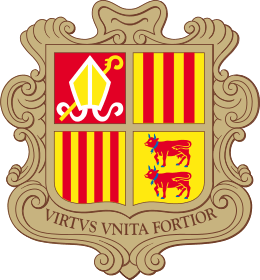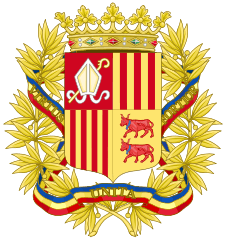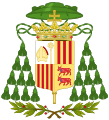Coat of arms of Andorra
| Coat of Arms of Andorra | |
|---|---|
 | |
| Details | |
| Armiger |
Emmanuel, Prince of Andorra Joan, Prince of Andorra |
| Adopted | 1993 (officially) |
| Escutcheon | Quarterly: first Gules, a crosier bendways sinister surmounted by a mitre Or lined Argent (Bishop of Urgell); second Or, three pallets Gules (Count of Foix); third Or, four pallets Gules (Catalonia); fourth Or, two cows passant in pale Gules horned and collared Azure (Viscount of Béarn). |
| Motto | Virtus Unita Fortior ("United virtue is stronger") |
The coat of arms of Andorra (Catalan: Escut d'Andorra) is the heraldic device consisting of a shield divided quarterly by the arms of the Bishop of Urgell and the Count of Foix – who have historically been the two co-princes of Andorra – in addition to the emblems of Catalonia and the Viscount of Béarn. Utilized unofficially since the Middle Ages, its status as the coat of arms of the Principality of Andorra was formalized in 1993 upon the implementation of their new constitution. The escutcheon is featured on the flag of Andorra.
History

The usage of the arms of the Bishop of Urgell and the Count of Foix stems from a settlement made in 1278 concerning territory sandwiched between the lands they had jurisdiction over.[1] The two parties agreed to protect the principality jointly as co-princes.[1][2] The arms of Catalonia and Béarn were added, and a "centuries-old carving" of this four-part quartered emblem is featured on the exterior of the country's parliament building[1] – the Casa de la Vall – which served as the meeting place of the General Council until 2014.[3] It was also found on the lintel of a house in Barcelona dating back to 1761.[4] However, its status was not official until it was designated as the principality's coat of arms under Article 2(2) of the Constitution of Andorra,[5] which was approved in a 1993 referendum and came into force that same year.[6]
Design
Construction
| Arms | Position | Explanation |
|---|---|---|
 |
Top left | The arms of the Bishop of Urgell, who is one of the two co-princes of Andorra. |
 |
Top right | The arms of the Count of Foix, the historical co-prince of Andorra who is currently represented by the President of France. |
 |
Bottom left | The arms of Catalonia. |
 |
Bottom right | The arms of the Viscounts of Béarn, the historical feudal lords of Andorra. |
Symbolism
The top two quarters depict the arms of the "two traditional protectors" of the principality – the Count of Foix and the Bishop of Urgell.[7] While the latter title is still extant and its holder continues to rule Andorra as a co-prince, the former was absorbed, first into the title of King of France, and subsequently transferred to the President of France.[8] The quarters at the bottom – of Catalonia and Béarn – allude to the other territories that Andorra has historically been reliant upon.[2] At the bottom is the country's motto – Strength united is stronger (Latin: Virtus unita fortior).[1][9]
Uses
The coat of arms is employed on the centre yellow band of the flag of Andorra.[9][10] It also features extensively on coins minted by Andorra.[4][11]
Variations
 |
| Coat of Arms of the High Authorities Co-Princes and Head of the Government |
.svg.png) Coat of arms before 16th century
Coat of arms before 16th century.svg.png) Coat of arms, 1580
Coat of arms, 1580 Ecclesiastical version (for Bishop of Urgell), c. 1800–1959
Ecclesiastical version (for Bishop of Urgell), c. 1800–1959 Coat of arms of French Co-Prince of Andorra (Historical), c. 1870–1959
Coat of arms of French Co-Prince of Andorra (Historical), c. 1870–1959.svg.png) Coat of arms, c. 1800–1949
Coat of arms, c. 1800–1949.svg.png) Coat of arms (Flag version) 1931–1949
Coat of arms (Flag version) 1931–1949.svg.png) Coat of arms, 1949–1959
Coat of arms, 1949–1959 Contemporary coat of arms
Contemporary coat of arms
See also
References
- 1 2 3 4 Smith, Whitney (February 2, 2001). "Flag of Andorra". Encyclopedia Britannica. Encyclopedia Britannica, Inc. Retrieved March 14, 2017.
- 1 2 Kindersley, Dorling (January 6, 2009). Complete Flags of the World. Dorling Kindersley Ltd. p. 134. Retrieved March 14, 2017.
- ↑ "Els Coprínceps inauguren el Consell General" (in Catalan). Andorra Difusió. June 12, 2014. Retrieved March 14, 2017.
- 1 2 Whitby, Joan (May 14, 1966). "Coin collecting corner". The StarPhoenix. Saskatoon. Retrieved March 15, 2017.
- ↑ "Constitution of the Principality of Andorra". General Council – Principality of Andorra. Government of Andorra. p. 11. Retrieved March 14, 2017.
- ↑ "Andorra Adopts Constitution For a Parliamentary System". The New York Times. March 15, 1993. Retrieved March 14, 2017.
- ↑ Shaw, Carol P. (2004). Flags. HarperCollins UK. p. 29. Retrieved March 15, 2017.
- ↑ "Andorra". World Tourism Organization. United Nations. Retrieved March 14, 2017.
- 1 2 "Andorra". The World Factbook. CIA. Retrieved March 14, 2017.
- ↑ Augustin, Byron (2009). Andorra. Marshall Cavendish. p. 37. Retrieved March 14, 2017.
- ↑ Palmer, Gary L. (April 10, 1981). "The Coin Box". Lodi News-Sentinel. Retrieved March 15, 2017.
